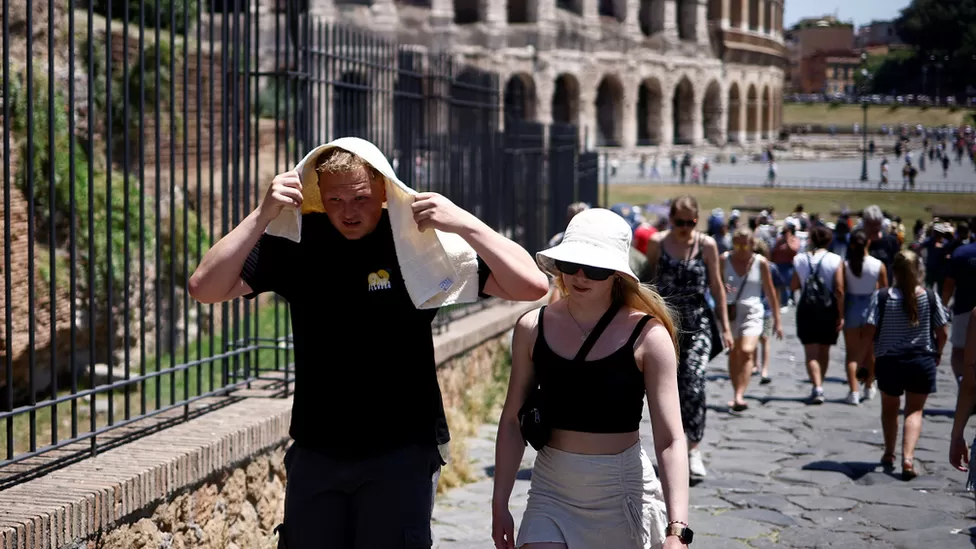As temperatures continue to rise, a heatwave is sweeping across parts of southern Europe and north-west Africa, bringing potential record-breaking temperatures in the coming days. The scorching heat is expected to surpass 40°C (104°F) in several countries, including Spain, France, Greece, Croatia, and Turkey. Italy, in particular, faces extreme conditions, with temperatures forecasted to reach as high as 48.8°C (119.8°F). Red alert warnings have been issued for cities like Rome, Bologna, and Florence. Unfortunately, this heatwave has already claimed lives and caused numerous heat-related incidents. In this article, we will explore the reasons behind this scorching summer, its impact on various regions, and provide essential information to stay safe in extreme heat conditions.
The Cerberus Heatwave: Unleashing Extreme Conditions
The current heatwave, known as the Cerberus heatwave, derives its name from the three-headed monster that appears in Dante’s inferno. This aptly named weather phenomenon is expected to bring unprecedented and extreme conditions to southern Europe and north-west Africa in the next few days. The intensity of this heatwave is a result of a combination of factors, including high-pressure systems and the influence of warm air masses from Africa.
Spain’s Sweltering Temperatures: A Heatwave’s Epicenter
Spain has been experiencing scorching temperatures for days, with the mercury soaring up to 45°C (113°F). The country has been gripped by intense heat, and overnight temperatures have not provided any respite, hovering above 25°C (77°F). Satellite images captured by the Copernicus Sentinel mission reveal land temperatures reaching a staggering 60°C (140°F) in the Extremadura region on Tuesday.
Italy’s High Alert: Battling the Merciless Heat
Italy finds itself on high alert as the heatwave tightens its grip on the country. With temperatures projected to reach 48.8°C (119.8°F), authorities have issued red alerts for ten cities, including Rome, Bologna, and Florence. Tragically, the heatwave has already claimed lives. In northern Italy, a man in his forties collapsed while painting zebra crossing lines in Lodi, near Milan, and later succumbed to the extreme heat.
France, Greece, Croatia, and Turkey: Feeling the Heatwave’s Intensity
The scorching heat is not limited to Spain and Italy alone. France, Greece, Croatia, and Turkey are also facing the wrath of the heatwave. Temperatures in these regions are expected to surpass 40°C (104°F), posing significant challenges for residents and tourists alike. It is crucial for individuals in these areas to take necessary precautions to safeguard their well-being during this period of extreme heat.
READ MORE:
The Executive Board of the International Monetary Fund (IMF) Approves Stand-By Arrangement for Pakistan
The Human Toll: Tragedies Caused by Heatstroke
The brutal heatwave has already resulted in tragedies and numerous incidents of heatstroke. Several tourists, including a British man outside the Colosseum in Rome, have collapsed due to the oppressive heat. These incidents underscore the urgent need for everyone, both locals and visitors, to be vigilant and take appropriate measures to prevent heat-related illnesses.
Understanding the Heatwave: Why This Summer Is So Hot
This summer’s extraordinary heat can be attributed to a combination of factors. Rising global temperatures due to climate change play a significant role in creating the conditions for such intense heatwaves. Additionally, natural climate patterns, such as high-pressure systems and warm air masses from Africa, contribute to the current scorching temperatures experienced across southern Europe and north-west Africa.
Tips to Stay Safe in Extreme Heat
During a heatwave, it is essential to prioritize personal safety and well-being. Here are some tips to help you stay safe and comfortable during extreme heat conditions:
- Stay hydrated: Drink plenty of water and avoid alcoholic and caffeinated beverages.
- Seek shade or air-conditioned spaces: Limit exposure to direct sunlight and spend time in cool environments.
- Dress appropriately: Wear loose, lightweight, and light-colored clothing to help your body regulate its temperature.
- Use sunscreen: Apply sunscreen generously to protect your skin from harmful UV rays.
- Limit outdoor activities: Minimize physical exertion during the hottest hours of the day.
- Check on vulnerable individuals: Keep an eye on the elderly, children, and those with pre-existing health conditions.
- Stay informed: Stay updated on weather forecasts and follow guidance from local authorities.




